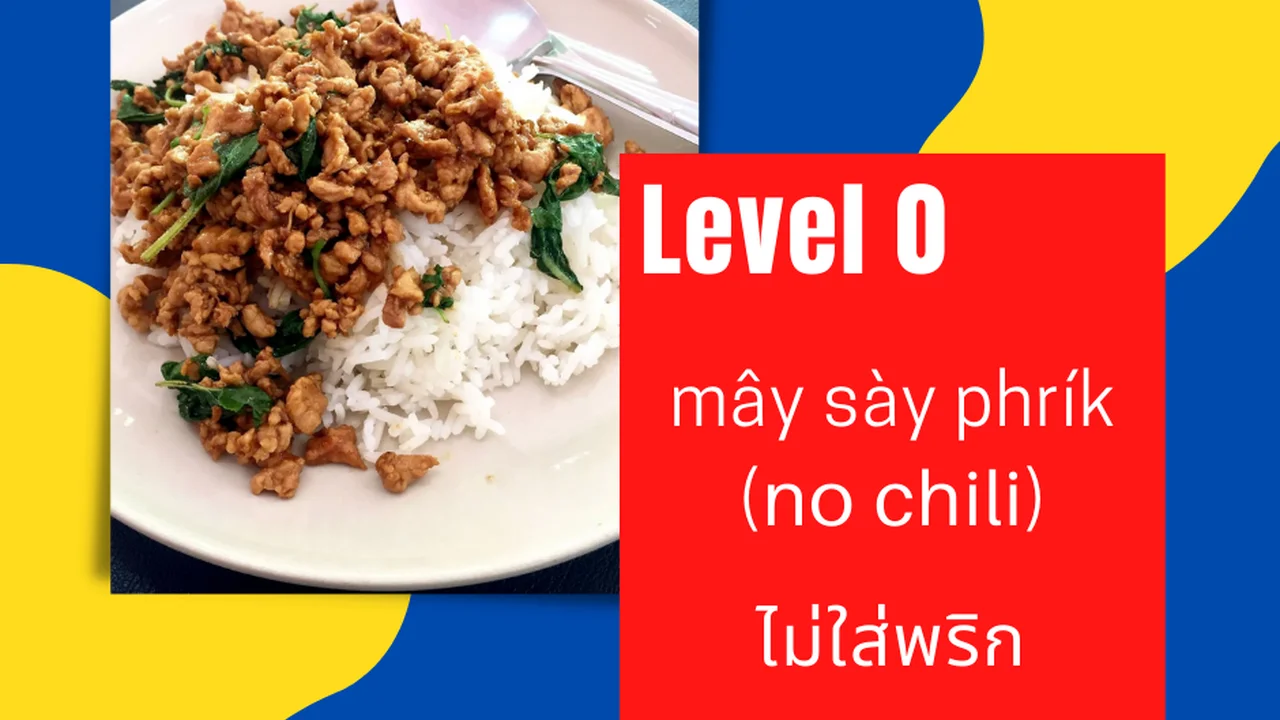Is Thai Food Spicy? A Guide to Spice Levels

Understanding Thai Chili Peppers Key Ingredients and Spice Levels
So, you're thinking about diving into the world of Thai food? Awesome! But maybe you're a little worried about the heat. "Is Thai food spicy?" is a question everyone asks before their first Pad Thai adventure. The short answer: it can be, but it doesn't have to be. Thai cuisine is all about balance – sweet, sour, salty, and yes, spicy. The spice comes primarily from chili peppers, and the type and amount used vary wildly from dish to dish and even from restaurant to restaurant.
Let's talk chili peppers. Thailand boasts a fantastic array of these fiery fruits, each with its own unique flavor profile and heat level. Some of the most common include:
- Bird's Eye Chili (Prik Kee Noo): These tiny but mighty peppers are the classic Thai chili. They pack a serious punch and are often used in curries, stir-fries, and dipping sauces. Think of them as the standard for "Thai spicy."
- Jinda Chili (Prik Jinda): Slightly larger than bird's eye chilis, Jinda chilis offer a more complex flavor with a slightly fruity note alongside the heat. They're often used in green curries and salads.
- Prik Yuak (Banana Pepper): These long, mild peppers are less about heat and more about adding bulk and a slightly sweet flavor to dishes. You'll often find them stuffed with meat or vegetables.
- Dried Chili Peppers (Prik Haeng): Dried chilis are used to add depth and smokiness to dishes. They're often rehydrated and ground into chili pastes.
The Scoville scale is the standard measurement for chili pepper heat. Bird's eye chilis can range from 50,000 to 100,000 Scoville Heat Units (SHU), while Jinda chilis are typically a bit lower. Banana peppers are practically non-existent on the Scoville scale. Understanding these basics is the first step to navigating the spicy world of Thai food.
Navigating the Menu Decoding Spice Levels and Asking Questions
Okay, you're at the restaurant, menu in hand. How do you avoid a fiery inferno in your mouth? First, look for descriptions. Many restaurants will indicate the spice level of each dish, often using chili pepper icons or phrases like "mild," "medium," or "hot." But remember, these are subjective! What one restaurant considers "medium" might be another's "extra spicy."
Don't be afraid to ask your server! Seriously, this is the best way to avoid disappointment (or a painful experience). Ask them to describe the spice level of a particular dish. You can say something like, "I'm sensitive to spice, is this dish very hot?" or "How many chili peppers would you rate this dish?"
Here's a pro tip: ask for the spice on the side. Many Thai restaurants will happily provide chili flakes, chili oil, or a small dish of sliced chilis so you can adjust the heat to your liking. This gives you complete control over the spiciness of your meal.
Must-Try Thai Dishes and Their Typical Spice Levels A Beginner's Guide
Let's explore some popular Thai dishes and their typical spice levels to give you a better idea of what to expect:
- Pad Thai: This classic noodle dish is usually mild to medium in spice. It's made with rice noodles, tofu, shrimp (or chicken), bean sprouts, peanuts, and a tangy tamarind sauce. If you're worried about spice, ask for it "mai pet" (not spicy).
- Green Curry (Gaeng Keow Wan): Green curry is typically medium to hot. It's made with green curry paste, coconut milk, bamboo shoots, eggplant, and meat (usually chicken or beef). The green chilis in the paste give it its characteristic heat.
- Red Curry (Gaeng Daeng): Similar to green curry but made with red curry paste, red curry is usually a bit milder, but it can still pack a punch.
- Tom Yum Soup: This hot and sour soup is a flavorful explosion of lemongrass, galangal, kaffir lime leaves, chili peppers, and mushrooms. It's typically medium to hot.
- Massaman Curry (Gaeng Massaman): This mild and creamy curry is influenced by Indian and Persian cuisine. It's made with coconut milk, potatoes, peanuts, and spices like cardamom and cinnamon. It's a great option for those who prefer less spice.
Spice-Reducing Strategies What to Do When the Heat Is On
Okay, so you accidentally ordered something too spicy. Don't panic! There are ways to cool down the heat:
- Rice: Plain white rice is your best friend. It helps to absorb the chili oil and dilute the spiciness.
- Coconut Milk: A spoonful of coconut milk can help to soothe the burning sensation.
- Sugar: A small amount of sugar can help to balance the flavors and reduce the perceived heat.
- Lime: A squeeze of lime juice can also help to cut through the spice.
- Dairy: Milk or yogurt can help to neutralize the capsaicin in chili peppers. However, this isn't always readily available in Thai restaurants.
Avoid drinking water! Water can actually spread the capsaicin around your mouth, making the burning sensation worse. Instead, opt for a sugary drink like Thai iced tea or a creamy coconut milk drink.
Recommended Products to Enhance Your Thai Food Experience
Want to bring the flavors of Thailand home? Here are a few product recommendations to help you create authentic Thai dishes in your own kitchen:
Thai Chili Paste Comparisons and Recommendations
Maesri Brand Red Curry Paste (Around $3 per can): This is a fantastic all-purpose red curry paste. It's readily available in most Asian grocery stores and online. Usage Scenario: Perfect for making red curry, stir-fries, and marinades. Comparison: Compared to other brands, Maesri offers a consistent flavor and a good balance of spice. It's spicier than some milder brands but less intense than homemade pastes. The price is a great value.
Pantai Norasingh Green Curry Paste (Around $4 per can): For a vibrant and aromatic green curry, Pantai Norasingh is a solid choice. Usage Scenario: Ideal for making green curry with chicken, beef, or tofu. Comparison: This paste has a slightly sweeter flavor than some other green curry pastes, with a prominent lemongrass aroma. It's a good option if you prefer a less intensely spicy green curry.
Lobo Brand Tom Yum Paste (Around $2.50 per packet): This convenient paste makes it easy to whip up a delicious Tom Yum soup. Usage Scenario: Use it to make a quick and flavorful Tom Yum soup at home. Just add water, mushrooms, and your choice of protein. Comparison: Lobo's Tom Yum paste is known for its authentic flavor and convenience. It's a great option for beginners who want to try making Tom Yum soup without having to gather all the individual ingredients.
Coconut Milk Brands for Creamy Thai Dishes
Aroy-D Coconut Milk (Around $2 per can): This is a high-quality coconut milk with a rich and creamy texture. Usage Scenario: Use it in curries, soups, desserts, and sauces. Comparison: Aroy-D is known for its high fat content, which results in a richer and creamier final product. It's a bit more expensive than some other brands, but the quality is worth it.
Chaokoh Coconut Milk (Around $1.50 per can): This is a more affordable option that still delivers good flavor and texture. Usage Scenario: Use it in curries, soups, and desserts. Comparison: Chaokoh is a good all-around coconut milk that's suitable for a variety of dishes. It's not quite as rich as Aroy-D, but it's still a solid choice.
Essential Sauces for Thai Cooking
Fish Sauce (Nam Pla) (Around $4 per bottle): Fish sauce is a staple ingredient in Thai cuisine. It adds a salty, savory, and umami flavor to dishes. Usage Scenario: Use it in stir-fries, curries, soups, and dipping sauces. Comparison: Look for fish sauce that is clear and amber-colored. Avoid fish sauce that is cloudy or has a strong, unpleasant odor. Squid Brand is a popular and widely available brand.
Soy Sauce (See Ew) (Around $3 per bottle): Soy sauce is another essential ingredient in Thai cuisine. It adds a salty and savory flavor to dishes. Usage Scenario: Use it in stir-fries, marinades, and dipping sauces. Comparison: Look for a good quality soy sauce that is dark and rich in color. Healthy Boy Brand is a popular brand in Thailand.
Experimenting with Spice Creating Your Perfect Thai Dish
The best way to find your perfect spice level is to experiment! Start with mild dishes and gradually increase the heat as you become more comfortable. Don't be afraid to ask for recommendations from your server or to adjust the spice level to your liking. Thai food is all about exploring new flavors and finding what you enjoy. So, go ahead and dive in – just be prepared for a little heat!
:max_bytes(150000):strip_icc()/277019-baked-pork-chops-with-cream-of-mushroom-soup-DDMFS-beauty-4x3-BG-7505-5762b731cf30447d9cbbbbbf387beafa.jpg)






